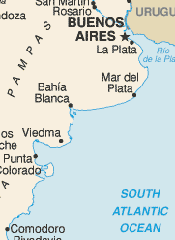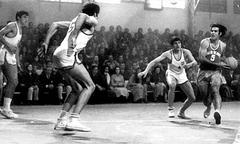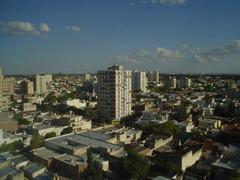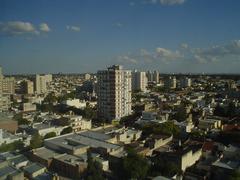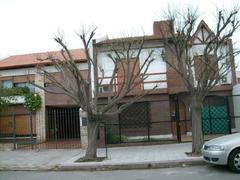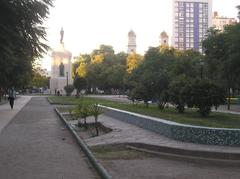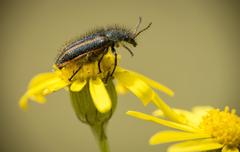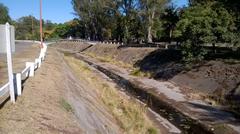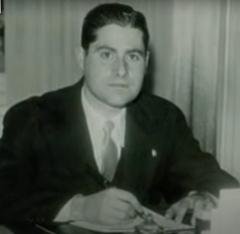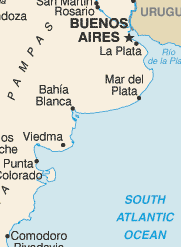
Bahía Blanca Visiting Hours, Tickets, and Historical Sites Guide
Date: 14/06/2025
Introduction to Bahía Blanca: History, Culture, and Visitor Essentials
Bahía Blanca, Argentina—often called the “White Bay”—is a vibrant coastal city rich in history, culture, and economic significance. Tracing its roots to Ferdinand Magellan’s first sighting in 1520, when he noted the white salt deposits lining its shores, Bahía Blanca officially became a city in 1828 with the founding of Fortaleza Protectora Argentina. Today, it is not only an industrial and logistical powerhouse owing to Argentina’s only naturally deep-water port, but also a hub of cultural activity, renowned for its theaters, museums, and festivals (Wikipedia, Welcome Argentina, Bahía Blanca Agenda, Puerto Bahía Blanca Vision 2040).
Visitors will find a city where historic landmarks—like the Monumento a las Banderas, a national symbol inaugurated in 1957—stand alongside contemporary art spaces, lively plazas, and culinary delights. This comprehensive guide provides up-to-date information on visiting hours, ticketing, accessibility, and insider tips to ensure a rewarding experience in Bahía Blanca. Whether you’re interested in exploring historical sites, enjoying cultural events, understanding the city’s economic landscape, or simply savoring local cuisine, this resource will help you make the most of your visit (Remote Expeditions, Wikivoyage).
Table of Contents
- Historical Overview and Economic Significance
- Essential Visitor Information
- Cultural Life and Top Attractions
- Visiting the Monumento a las Banderas
- Frequently Asked Questions (FAQ)
- Conclusion and Recommendations
- References and Official Links
Historical Overview and Economic Significance
Early Encounters and Naming
The name “Bahía Blanca” comes from the white salt deposits on its shores, noted by Ferdinand Magellan during his 1520 expedition, who called the area “Baxos de arenas blancas.” This distinctive feature inspired the city’s enduring name (Wikipedia).
Founding and Early Settlement
Despite early exploration, European settlement began in earnest in the 1820s. After Captain Morel charted the bay in 1822 and Valentín García surveyed the area in 1823, the Fortaleza Protectora Argentina was established in 1828 by Ramón Estomba—a foundational event now celebrated as the city’s birthday. The city grew around this fort, developing key infrastructure such as ports, railways, and warehouses (Welcome Argentina).
Growth Through Transportation and Trade
The arrival of the railway in 1884 was a turning point, connecting Bahía Blanca to the Pampas, Buenos Aires, and the south, and transforming it into a major export center for grains, wool, and other products (Welcome Argentina).
Urban and Cultural Development
By the late 19th and early 20th centuries, Bahía Blanca had become a dynamic urban center. Architectural landmarks like the Municipal Theater and San Francisco Cathedral reflect European influences, while museums and public parks enrich the city’s cultural life (Triplyzer).
Economic Significance
Bahía Blanca’s deep-water port is Argentina’s only naturally deep port, allowing it to handle large cargo volumes and making it a strategic export hub. The port complex includes Puerto Ingeniero White (grains and containers) and Puerto Galván (oils and chemicals), with major industrial facilities such as Profertil’s urea plant (Wikipedia, Puerto Bahía Blanca Vision 2040).
The city is a multimodal logistics hub, with well-developed rail, road, and maritime connections to Mendoza, Neuquén, and Buenos Aires. It handles over 27 million tons of goods annually and supports industries ranging from petrochemicals and energy to agro-industry and shipping. Ongoing investments and collaboration between port authorities and the municipality aim for sustainable growth and community development (Puerto Bahía Blanca Vision 2040, Climameter).
Essential Visitor Information
Visiting Hours and Tickets for Major Historical Sites
- Fortaleza Protectora Argentina: Open Tuesday–Sunday, 9 AM–6 PM. Adults: ARS 300; students/seniors: discount rates.
- Municipal Theater: Guided tours weekdays, 10 AM–4 PM. Tickets: ARS 200–400.
- San Francisco Cathedral: Open daily, 8 AM–7 PM. Free entry.
Accessibility and Travel Tips
- Air: Presidente Perón Airport offers flights from Buenos Aires and other cities.
- Bus/Train: Well-connected to Mendoza, Neuquén, and Buenos Aires (Remote Expeditions).
- Local Transport: Buses (SUBE card), taxis, and remises are widely available. The city center is walkable, with bike rentals offered (Wikivoyage).
- Best Seasons: Spring (September–November) and autumn (March–May) for mild weather.
Photographic and Nearby Attractions
- Estancia La Elvira: Historic ranch with rural tours.
- Parque de Mayo: Largest city park for leisure and photography.
- Bahía Blanca Waterfront: Stunning bay views, especially at sunset.
Special Events and Guided Tours
- Festivals: Festival Nacional de Jazz, National Cheese Festival, and more.
- Tours: Walking and bike tours available via local agencies and the tourism office.
Cultural Life and Top Attractions
Architectural Heritage and Historic Sites
- Plaza Rivadavia: City’s architectural heart, surrounded by the Municipal Palace and Catedral Nuestra Señora de la Merced. Cathedral hours: Mon–Sat, 9 AM–12 PM & 4 PM–7 PM. Free admission, guided tours via tourist office (Wikivoyage).
- Ingeniero White Port District: Accessed via bus 500, features Museo del Puerto de Ingeniero White (Tue–Sun, 10 AM–6 PM, free) and Ferrowhite Museo Taller (Wed–Sun, 11 AM–5 PM, voluntary donation).
Museums and Cultural Institutions
- Museo de Informática Espacio Tec: Thompson 665, Thu–Sat, 3–7 PM, free entry (Bahía Blanca Agenda).
- Museo de la Aviación Naval Argentina: Comandante Espora Air Base, Tue–Sun, 9 AM–5 PM, free with registration (Wikivoyage).
- MAC (Museos de Bellas Artes): Modern and contemporary art, Tue–Fri 11 AM–6 PM, Sat 10 AM–2 PM, free (Bahía Blanca Agenda).
Performing Arts and Events
- Teatro Municipal: Avenida Alem. Box office Mon–Fri, 10 AM–6 PM. Show tickets: ARS 500–1500 (Wanderlog).
- Independent Venues: Casa del Pueblo, El Espejo Espacio Cultural, Centro Cultural Cooperativa Obrera.
Major Festivals
- Spring Festival (Fiesta de la Primavera): April.
- Winter Vacation Activities: July–August.
- Art and Music Fairs: Year-round (Bahía Blanca Agenda).
Libraries and Parks
- Biblioteca Popular Bernardino Rivadavia: Mon–Fri, 9 AM–7 PM (Bahía Blanca Agenda).
- Parque de Mayo: Dawn to dusk. Other parks: Vicente Boronat, Noroeste, Bosque de Paz.
Nightlife and Gastronomy
- Avenida Alem: Restaurants, bars, nightclubs (11 PM–4 AM).
- Ingeniero White: Alternative nightlife, especially during festivals.
- Cuisine: Italian, Spanish, Argentine fusion. Note: alcohol sales in stores until 10:30 PM; bars open late.
Contemporary Arts and Community Initiatives
Frequent exhibitions, workshops, and community fairs engage visitors in printmaking, dance, and local crafts.
Visiting the Monumento a las Banderas
History and Significance
Inaugurated in 1957, the Monumento a las Banderas celebrates the flags and milestones of Argentina’s history. Sculpted by renowned Argentine artists, it is a focal point for national events like Independence Day and Flag Day.
Visiting Hours and Access
- Open 24 hours daily in a central public plaza; beautifully illuminated after dark.
- Free entry. Guided tours available via the Bahía Blanca Tourist Office.
Getting There
- Location: City center, walkable from main hotels and attractions. Accessible by public transport and taxis.
- Parking: Available nearby.
- Accessibility: Wheelchair-friendly with ramps and paved paths.
Guided Tours and Events
- Tours: Scheduled in mornings and late afternoons, providing historical context and symbolism.
- Special events: Ceremonies and performances on national holidays.
Photography and Nearby Sights
- Best light: Sunrise, sunset, and nighttime for illuminated views.
- Nearby: Bahía Blanca Historical Museum, Ingeniero White port area, local cafés, and parks.
Frequently Asked Questions (FAQ)
Q: What are the visiting hours for Bahia Blanca’s main historical sites?
A: Fortaleza Protectora Argentina: Tue–Sun, 9 AM–6 PM; Municipal Theater: guided tours weekdays, 10 AM–4 PM; San Francisco Cathedral: daily, 8 AM–7 PM.
Q: Are tickets required for museums?
A: Many museums are free; Ferrowhite requests a voluntary contribution. Some workshops may have fees.
Q: How can I access guided tours?
A: Available at major sites and through the tourism office; advance booking recommended.
Q: Is the Monumento a las Banderas accessible for visitors with disabilities?
A: Yes, with paved paths and ramps.
Q: What’s the best time for cultural events?
A: Spring (April) and winter vacation periods (July–August) have the most activities.
Q: Are dining options available near major sites?
A: Yes, especially near Plaza Rivadavia and Avenida Alem.
Conclusion and Recommendations
Bahía Blanca offers a harmonious blend of historical depth, cultural dynamism, and economic vitality. From iconic landmarks like the Monumento a las Banderas and Fortaleza Protectora Argentina to contemporary museums, lively festivals, and a thriving port, the city welcomes visitors with open arms and diverse experiences. Comprehensive accessibility, a range of attractions, and a friendly urban atmosphere make Bahía Blanca an ideal destination for cultural explorers, history buffs, and business travelers alike.
Plan your visit today:
- Download the Audiala app for maps, updated hours, and guided tours.
- Check the Bahía Blanca Agenda for current events.
- Utilize local tours for deeper insights.
- Explore our related posts and social media channels for real-time tips and inspiration.
References and Official Links for Bahía Blanca
- Wikipedia: Bahía Blanca
- History of Bahía Blanca – Welcome Argentina
- Bahía Blanca Cultural Agenda
- Puerto Bahía Blanca Vision 2040
- How to Get Around Argentina – Remote Expeditions
- Bahía Blanca on Wikivoyage
- Triplyzer: Things to Do in Bahía Blanca
- Wanderlog: Top Attractions in Bahía Blanca
- Climameter: Argentina Floods
- Bahía Blanca Tourism Office
